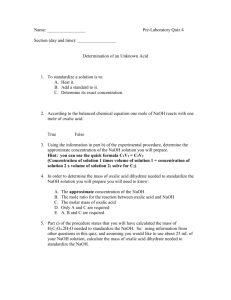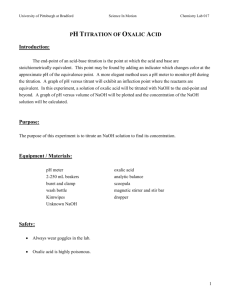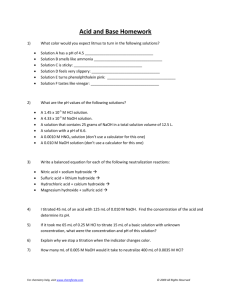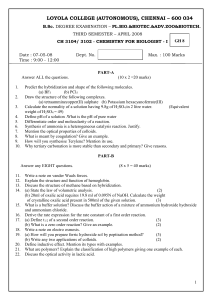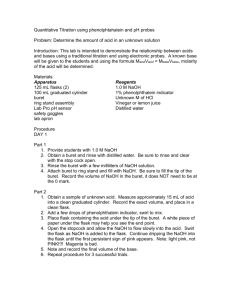Experiment 12A: Standardization of a Base
advertisement
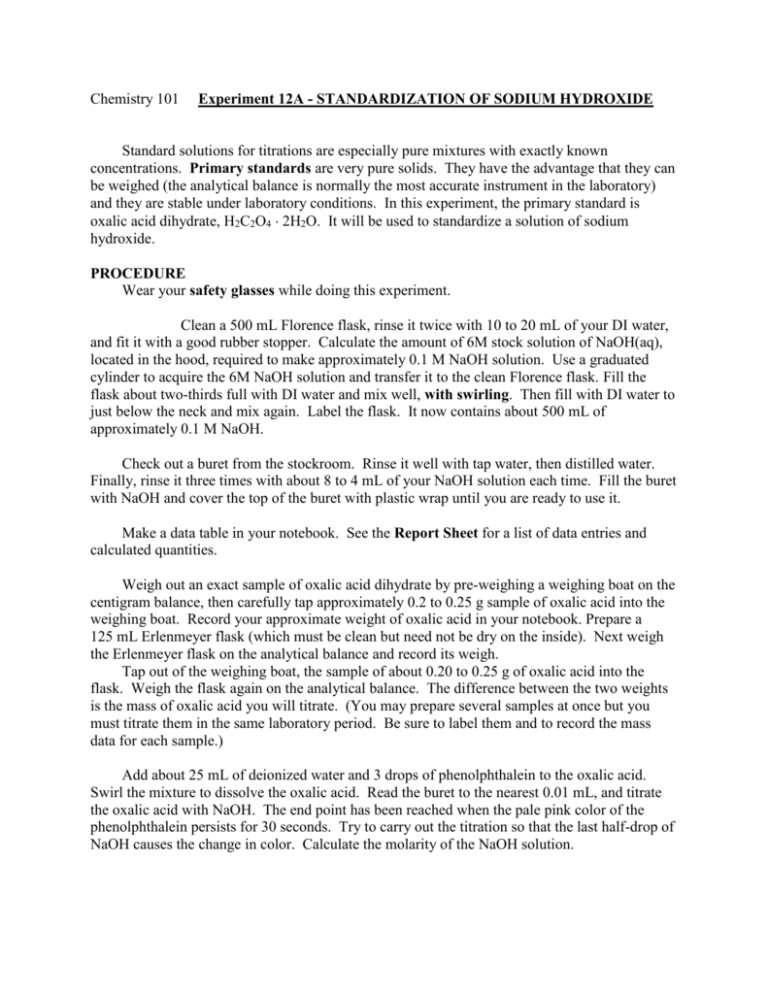
Chemistry 101 Experiment 12A - STANDARDIZATION OF SODIUM HYDROXIDE Standard solutions for titrations are especially pure mixtures with exactly known concentrations. Primary standards are very pure solids. They have the advantage that they can be weighed (the analytical balance is normally the most accurate instrument in the laboratory) and they are stable under laboratory conditions. In this experiment, the primary standard is oxalic acid dihydrate, H2C2O4 2H2O. It will be used to standardize a solution of sodium hydroxide. PROCEDURE Wear your safety glasses while doing this experiment. Clean a 500 mL Florence flask, rinse it twice with 10 to 20 mL of your DI water, and fit it with a good rubber stopper. Calculate the amount of 6M stock solution of NaOH(aq), located in the hood, required to make approximately 0.1 M NaOH solution. Use a graduated cylinder to acquire the 6M NaOH solution and transfer it to the clean Florence flask. Fill the flask about two-thirds full with DI water and mix well, with swirling. Then fill with DI water to just below the neck and mix again. Label the flask. It now contains about 500 mL of approximately 0.1 M NaOH. Check out a buret from the stockroom. Rinse it well with tap water, then distilled water. Finally, rinse it three times with about 8 to 4 mL of your NaOH solution each time. Fill the buret with NaOH and cover the top of the buret with plastic wrap until you are ready to use it. Make a data table in your notebook. See the Report Sheet for a list of data entries and calculated quantities. Weigh out an exact sample of oxalic acid dihydrate by pre-weighing a weighing boat on the centigram balance, then carefully tap approximately 0.2 to 0.25 g sample of oxalic acid into the weighing boat. Record your approximate weight of oxalic acid in your notebook. Prepare a 125 mL Erlenmeyer flask (which must be clean but need not be dry on the inside). Next weigh the Erlenmeyer flask on the analytical balance and record its weigh. Tap out of the weighing boat, the sample of about 0.20 to 0.25 g of oxalic acid into the flask. Weigh the flask again on the analytical balance. The difference between the two weights is the mass of oxalic acid you will titrate. (You may prepare several samples at once but you must titrate them in the same laboratory period. Be sure to label them and to record the mass data for each sample.) Add about 25 mL of deionized water and 3 drops of phenolphthalein to the oxalic acid. Swirl the mixture to dissolve the oxalic acid. Read the buret to the nearest 0.01 mL, and titrate the oxalic acid with NaOH. The end point has been reached when the pale pink color of the phenolphthalein persists for 30 seconds. Try to carry out the titration so that the last half-drop of NaOH causes the change in color. Calculate the molarity of the NaOH solution. Repeat the titration and calculations until you have three determinations that agree within 5 parts per thousand (0.5%). You may use the Q test to reject “bad” values. Remember, you will need this solution for part B, so do not use it all up! A “shortcut” to check agreement of values during the experiment is to calculate the ratio of volume of base for a trial divided by the mass of oxalic acid used in that trial. If this ratio varies only in the last significant figure for three trials, the calculated molarities will also have little variation. This calculation can also be used to predict the base volume required to titrate any sample of oxalic acid, once one accurate trial has been completed. Ask your instructor to explain if you cannot reason out this method. When all titrations are completed, drain the buret, rinse it with three portions of tap water and three portions of deionized water, and return it to the stockroom. KEEP THE REMAINING NaOH SOLUTION FOR PART 12B. Chemistry 101 Experiment 12A - STANDARDIZATION OF SODIUM HYDROXIDE Section_________________ Name______________________ Pre-Laboratory Assignment 1. The density of 50% NaOH solution is about 1.5 g/mL. Calculate the volume of 50% NaOH solution that contains 0.050 mole of NaOH. 2. Calculate the molarity of a NaOH solution if 32.02 mL of the solution neutralizes 0.2262 g of oxalic acid dihydrate. 3. Will the calculated molarity of the NaOH solution be too high or too low if a student “overshoots” the end point of the titration? Explain. Chemistry 101 Experiment 12A - STANDARDIZATION OF SODIUM HYDROXIDE Section_______________ Name______________________ Report Sheet For each titration, you will report the following. Repeat the data table and calculations for each titration. Finally, tabulate the values for the molarity; calculate the average value and the average deviation. See the “Measurement” experiment for this procedure and for the Q test. Data: Mass of vial and oxalic acid dihydrate _____________ Mass of vial less sample _____________ Mass of sample _____________ Initial buret reading _____________ Final buret reading _____________ Volume of NaOH _____________ Calculations: Moles oxalic acid dihydrate used _____________(A) Moles NaOH used [2x(A)] _____________(B) Volume of NaOH (liters) _____________(C) Molarity of NaOH [(B)/(C)] _____________ Include an example of your calculations with your report. Chemistry 101 Experiment 12A - STANDARDIZATION OF SODIUM HYDROXIDE Post laboratory Questions 1. Calculate the mass of acetic acid (HC2H3O2) that would be neutralized by 28.67 mL of your NaOH solution. Write the equation for the reaction, and show your method of calculation. 2. Potassium hydrogen oxalate can also be used as a primary standard. Its formula is KHC2O4 H2O. When this compound is used to react with 0.1 M NaOH, we would not use 0.2 g samples, as we did with our oxalic acid dihydrate. Would the correct sample size of potassium hydrogen oxalate monohydrate be greater or less than 0.2 g? Explain.
